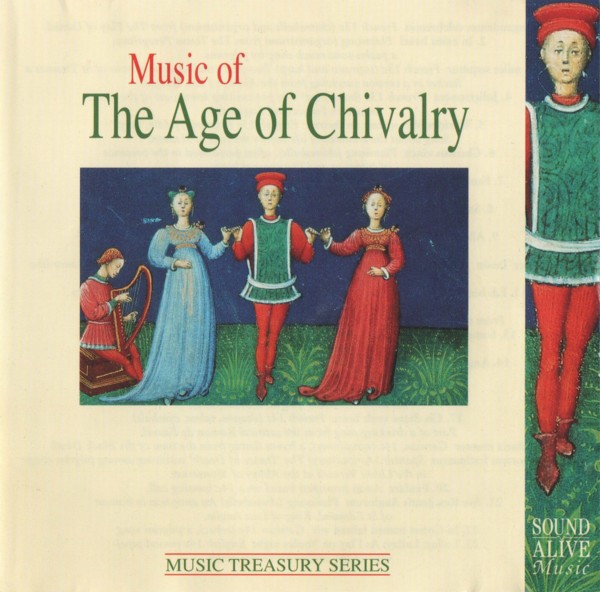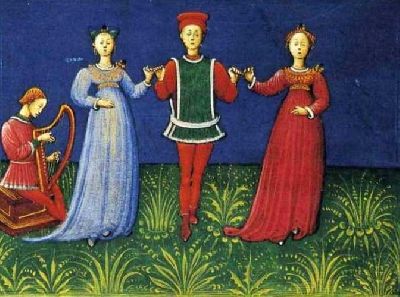
medieval.org
Soundalive Music SAMMT/CD 101
1987, 1995
1. Congaudentes celebremus [1:01] chimebells and organistrum
French 13c, from The Play of Daniel.
2. In exitu Israel [1:06] organistrum
Plainsong from The Tonus Peregrinus, a psalm-tone much sung by pilgrims.
3. Novus miles sequitur [1:10] soprano and harp Hu 102
French 13c. Two-part conductus in honour of St Thomas, a Becket in a version surviving from the Abbey of Las Hueglas.
4. Joliettement [0:41] bone pipe Mo 349
French 13c. The pre-existing tenor part of the motet known in France and England.
5. Worldes bliss ne last no throwe [1:40] soprano, fiddle, harp
English 13c.Song about the troubles of life before the joys of Heaven.
6. Christus vincit [2:51] chimebells
Plainsong, often performed in the presence of Norman and Plantagenet kings.
7. Fanfare [0:44] trumpet
The Cracow Hejnel, believed to have been played in the battle against the Turks in 1241.
8. Santa Maria strela do dia [1:10] psaltery CSM 100
from the Cantigas of Santa Maria of Alfonso X 'The Wise' of Castile.
9. Alle psallite cum luya [1:15] soprano, psaltery Mo 339
Although the music is English, the song survives in a French source which is used here.
10. Chose Tassin [0:41] rebec and tabor Mo 347
French 13c. Surviving as the tenor part of a motet, this dance-like melody is thought to be by the Parisian minstrel Tassin.
11. Edi beo thu, hevene quene [1:48] soprano and harp
English 13c. A hymn to Our Lady.
12. Ma viele [0:44] fiddle
Gautier de Coinci, c1177-1236. From the collection of Miracles de Nostre Dame by the Prior of Vic-sur-Aisne.
13. Sumer is icumen in [0:32] pipe and tabor
The main tune from the celebrated round from Reading Abbey.
14. Angelus ad Virginem [1:39] portative organ
English 14c, an Annunciation hymn, mentioned in Chaucer's Canterbury Tales.
15. Marionette douce [0:58] psaltery
English, c1300.
16. Bryd one brere [0:49] rebec
English, c1300.
17. Cis chans veult boire [0:21] shawm, tabor, cymbals
French 14c. Part of a drinking song from the satirical Roman de Fauvel.
18. Maria muoter [0:52] symphony
German, 14c, a hymn dating from the time of the Black Death.
19. Ad mortem festinamus [0:57] psaltery LV 10
Spanish 14c. The 'Dance of Death' surviving among pilgrim songs in the Llibre Vermell at the Abbey of Monserrat.
20. Fanfare [0:24] trumpet
Anon. based on a 14c hunting call.
21. Ave Rex gentis Anglorum [0:52] chimebells
Plainsong. An antiphon in honour of St Edmund, King of East Anglia.
22. In Gottes namen fahren wir [1:16] rebec
German 14c, a pilgrim song.
23. Lullay, Lullay: As I lay on Yooles night [0:52] wood pipe
English 14c. One of the earliest surviving carols.
24. Douce dame jolie [1:04] mandora
Guillaume de Machaut c1300-1377, by the greatest French composer of the time.
25. Trotto [0:54] portative organ
Italian 14c, a lively dance tune.
26. Verbum caro factum est [0:44] soprano, gittern
Italian 14c, text by the Franciscan Richard de Ledrede, Bishop of Ossory.
27. Me lylcyth ever the lenger the bet [0:46] recorder
English 14c, part of a song in praise of Winchester.
28. Scribere proposui [0:48] two gitterns
Anon 14c, a dance melody.

The Musicians:
Mary Remnant: harp, pasaltery, gittern, mandora, rebec, fiddle, organistrum, symphony, portative organ,
bone pipe, wood pipe, recorder, pipe and tabor, shawm, chimebells, percussion
Petronela Dittmer: Soprano and organistrum
Mathew Hart Dyke: Trumpet
Cover illustration: Lombardo School's A Gentleman Dancing with Two Ladies
by kind permission of Bibliotheque Nationale, Paris
© & ℗ 1987, 1995 Soundalive Music Limited
Soundalive Music is part of the International Heritage Corporation